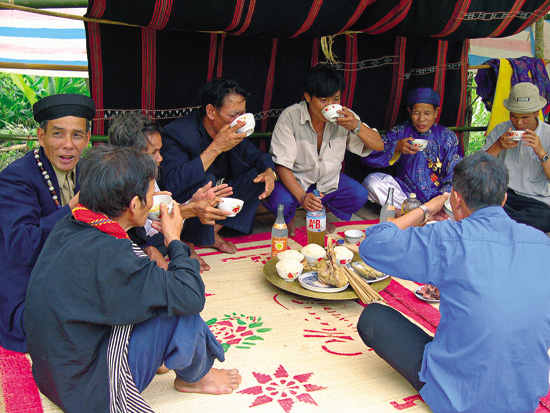
Pictures: At a C? Tu wedding
Vietnam Heritage, November-December 2011 — The C? Tu ethnic minority has at least 23 clans. Marriages between members of a clan are banned. In September or October, when they harvest their crops, the C? Tu celebrate. It is time for young men to build a cabin or hut on their farms or at the edge of the forest.
A C? Tu young man and a young woman may sleep together for three to five days in a hut to understand each other and not have sex.
The man is heavily penalised if the woman gets pregnant before their wedding. He may have to slaughter pigs, cows or buffaloes, and give some meat to each household in the village. He may also have to give the woman’s family such things as jars or jewellery as a penalty. He may be exiled from the village.
When they realise they have made a good match, the young man usually gives his partner a three-compartment basket that he weaves himself, and the young woman gives her partner a floral shirt she has made.
If the young man is from a rich family, he may give his partner a ring or a necklace made of precious stone. Then, he tells his parents to find a marriage broker.
A marriage broker must be a gentle, elderly man with good conduct who is respected by the community. The broker helps set up a marriage bond between the two families.
After the broker’s successful negotiation with the young woman’s family, the man’s family prepares wine, betel and areca nuts and some jars (jars are used to contain wine and considered valuable property by many hill tribes), which later become the property of the couple.
They then hold a ceremony with relatives of both families attending. About three months to a year later, their wedding is held.
After a date has been chosen for their wedding, the young man’s family chooses adults, especially knowledgable ones, who then go to the young woman’s house.
They drink wine and talk about the wedding in a way that sounds like singing. They mention springs, trees, forests and animals to express their ideas.
On the wedding day, a party from the man’s family carries jars, rice, sticky rice and a buffalo to the woman’s family. A poor man must have at least two or three pigs. A buffalo is usually killed to celebrate the wedding, and a buffalo-sacrifice ceremony is held.
Three years after the wedding, the man’s family kills a chicken and cooks a tray of sticky rice. Both families are present. The host prays to gods so that the young couple will have good health, make their own living and give birth to lots of children.
After the ritual, the young couple and the two families sit around the tray of sticky rice and chicken to get the food and give it to each other, and drink wine from the same straw.
After this ceremony, the couple definitively may have sex and produce children. From then on, the woman must live in the man’s family. These rules are strictly observed; couples rarely have sex during the three years before this ritual.n
*Nguyen Van Son has been working at Quang Nam museum since 1997 and has been studying the culture of the C? Tu.

